Spatial and Temporal Variation in Alpine Vegetation Phenology and Its Response to Climatic and Topographic Factors on the Qinghai–Tibet Plateau
Abstract
1. Introduction
2. Materials and Methods
2.1. Study Area Overview
2.2. Data Sources and Data Pre-Processing
2.3. Research Methods
2.3.1. Phenological Metrics
2.3.2. Theil–Sen Median Slope Estimation and Mann–Kendall (MK) Non-Parametric Test
2.3.3. Partial Correlation Analysis
- (1)
- Calculate the correlation coefficient:
- (2)
- Calculate the partial correlation coefficient:
3. Results
3.1. Spatial and Temporal Distribution of Alpine Vegetation Phenology on QTP during 2001–2020
3.1.1. Spatial Distribution of the Mean Values of Alpine Vegetation Phenology on the QTP
3.1.2. Inter-Annual Variation of Alpine Vegetation Phenology on the QTP
3.1.3. Inter-Annual Phenological Variation of Different QTP Alpine Vegetation Types
3.2. Response of Alpine Vegetation Phenology to Climate Change and Altitude Gradient
3.2.1. Inter-Annual Variation of Temperature and Precipitation in QTP
3.2.2. Response of Alpine Vegetation Phenology to Annual Climate Change
3.2.3. Response of Alpine Vegetation Phenology to Climate Change in the 30 Days before SOG and EOG
3.2.4. Differences in the Ratio of Pixel Response to Precipitation and Temperature in Different Alpine Vegetation Phenology
3.2.5. Response of Different Types of Alpine Vegetation Phenology to Altitude Gradient
4. Discussion
5. Conclusions
- (1)
- Alpine vegetation SOG on the QTP was increasingly delayed from southeast to northwest, with an early inter-annual variation rate of 0–1 d year−1 and SOG ranging from days 120 to 140. EOG gradually increased from northeast to southwest, with inter-annual variation increasingly delayed by 0–1 d year−1, and EOG ranging from days 260 to 280. The SOG of the alpine meadow, alpine steppe and alpine shrub were concentrated between days 120 and 140, and their inter-annual variation rate was 0–1 d year−1. The EOG of the alpine shrub and alpine steppe were concentrated between days 280 and 300, the alpine meadow was concentrated between days 260 and 280, and their inter-annual variation rate was 0–1 d year−1 for all three.
- (2)
- Temperature and precipitation both affected alpine vegetation growth. Alpine vegetation SOG was negatively correlated with temperature and precipitation and gradually decreased from east to west, while the alpine vegetation EOG was positively correlated with temperature and precipitation and gradually increased from east to west. Moreover, there was a significant negative correlation between the mean temperature in the 30 days before SOG and the alpine vegetation SOG and a positive correlation between mean total precipitation in the 30 days before SOG and the alpine vegetation SOG, with the negative correlation covering a wider area than that covered by the positive correlation. A significant positive correlation was observed between mean total precipitation in the 30 days before EOG (similar to the results for the mean temperature in the 30 days before EOG and the alpine vegetation EOG), as well as between the mean annual temperature and the alpine vegetation EOG. The responses of the different types of alpine vegetation phenology to precipitation and temperature (mean annual cumulative precipitation, mean annual temperature, mean total precipitation and mean temperature in the 30 days before SOG(EOG)) at different periods were different. In particular, the response of the alpine vegetation phenology to the mean total precipitation in the 30 days before SOG (EOG) was more significantly positively correlated with the mean annual cumulative precipitation, and the change was most apparent in the alpine steppe. The response of the alpine vegetation phenology was positively correlated with the mean temperature in the 30 days before SOG (EOG) compared to the mean annual temperature, which was more significant, showing the greatest significance in the alpine meadow.
- (3)
- The alpine vegetation phenology is closely related to the altitude gradient. Based on the maximum altitude boundaries for an alpine meadow of 2400 m, for the alpine steppe of 2800 m, and for the alpine shrub of 2600 m, inter-annual SOG change rates below the boundaries were mainly delayed, while inter-annual SOG change rates above the boundaries tended to be early. Based on maximum altitude boundaries for the alpine meadow of 2600 m, for the alpine steppe of 2800 m, and for the alpine shrub of 2000 m, inter-annual EOG change rates below the boundaries were mainly early, while inter-annual EOG changes rates above the boundaries tended to be delayed.
Author Contributions
Funding
Institutional Review Board Statement
Informed Consent Statement
Data Availability Statement
Acknowledgments
Conflicts of Interest
References
- Zhang, B.; Cao, J.; Bai, Y.; Zhou, X.; Ning, Z.; Yang, S.; Liu, L. Effects of rainfall amount and frequency on vegetation growth in a Tibetan alpine meadow. Clim. Changes 2013, 118, 197–212. [Google Scholar]
- Jin, Z.; Zhuang, Q.; He, J.; Luo, T.; Shi, Y. Phenology shift from 1989 to 2008 on the Tibetan Plateau: An analysis with a process-based soil physical model and remote sensing data. Clim. Changes 2013, 119, 435–449. [Google Scholar]
- Xue, T.; Zhao, Y.; Chen, X.; Jiang, M.; Liang, B. Effects of air temperature and soil moisture on common brown-down date of Taraxacum mongolicum in Eastern China’s temperate zone. Acta Sci. Nat. Univ. Pekin. 2020, 56, 173–183. [Google Scholar]
- Loveland, T.R.; Reed, B.; Brown, J.; Ohlen, D.; Zhu, Z.; Yang, L.; Merchant, J.W. Development of a global land cover characteristics database and IGBP DIS-Cover from 1 km AVHRR data. Int. J. Remote Sens. 2010, 21, 1303–1330. [Google Scholar]
- Wang, W.; Fang, J. Soil respiration and human effects on global grasslands. Glob. Planet. Change 2009, 67, 20–28. [Google Scholar]
- Yao, T.; Thompson, L.; Mosbrugger, V.; Zhang, F.; Ma, Y.; Luo, T.; Xu, B.; Yang, X.; Joswiak, D.; Wang, W.; et al. Third Pole Environment (TPE). Environ. Dev. 2012, 3, 52–64. [Google Scholar]
- Pepin, N.; Bradley, R.; Diaz, H.; Baraer, M.; Caceres, E.; Forsythe, N.; Fowler, H.; Greenwood, G.; Hashmi, M.; Liu, X.; et al. Elevation-dependent warming in mountain regions of the world. Nat. Clim. Change 2015, 5, 424–430. [Google Scholar]
- Tucher, C.; Pinzon, J.; Brown, M.; Slayback, D.; Pak, E.; Mahoney, R.; Saleous, E. An extended AVHRR 8-km NDVI dataset compatible with MODIS and SPOT vegetation NDVI data. Int. J. Remote Sens. 2005, 26, 4485–4498. [Google Scholar]
- Cong, N.; Wang, T.; Nan, H.; Ma, Y.; Wang, X.; Myneni, R.; Piao, S. Changes in satellite-derived spring vegetation green-up date and its linkage to climate in China from 1982 to 2010: A multimethod analysis. Glob. Change Biol. 2013, 19, 881–891. [Google Scholar]
- Huang, W. Apline Grassland Phenology Response to Climate Change over Tibetan Plateau; Lanzhou University: Lanzhou, China, 2019. [Google Scholar]
- An, C. Monitoring of Vegetation Phenology Based on MODIS Data and Its Response to Climate Change in Tibetan Plateau, China; University of Chinese Academy of Sciences: Beijing, China, 2019. [Google Scholar]
- Yu, H.; Luedeling, E.; Xu, J. Winter and spring warming result in delayed spring phenology on the Tibetan Plateau. Proc. Natl. Acad. Sci. USA 2010, 107, 22151–22156. [Google Scholar] [PubMed]
- Li, L.; Liu, L.; Zhang, Y.; Ding, M.; Li, S.; Chen, Q. Elevation-dependent alpine grassland phenology on the Tibetan Plateau. Geogr. Res. 2017, 36, 26–36. [Google Scholar]
- Zhang, G.; Zhang, Y.; Dong, J.; Xiao, X. Green-up dates in the Tibetan Plateau have continuously advanced from 1982 to 2011. Proc. Natl. Acad. Sci. USA 2013, 110, 4309–4314. [Google Scholar]
- Zhang, Y.; Li, B.; Liu, L.; Zheng, D. Redetermine the region and boundaries of Tibetan Plateau. Geogr. Res. 2021, 40, 1543–1553. [Google Scholar]
- Rodriguez, E.R.; Becu, O.; Coppola, D.; Duquerroy, L.; Rinaldo, R.; Schoenenberg, A.; Ginati, A. Integrated applications demonstration projects. In Proceedings of the 2012 IEEE 1st AESS European Conference on Satellite Telecommunications, ESTEL 2012, Rome, Italy, 2–5 October 2012. [Google Scholar]
- Yao, T.; Xue, Y.; Chen, D.; Chen, F.; Thompsom, L.; Cui, P.; Koike, T.; Lau, W.K.; Lerrenmaier, D.; Mosbrugger, V.; et al. Recent third pole’s rapid warming accompanies cryospheric melt and water cycle intensification and interactions between monsoon and environment: Multidisciplinary approach with observations, modeling, and analysis. Bull. Am. Meteorol. Soc. 2019, 100, 423–444. [Google Scholar]
- Shen, M.; Tang, Y.; Chen, J.; Zhu, X.; Zheng, Y. Influences of temperature and precipitation before the growing season on spring phenology in grasslands of the central and eastern Qinghai-Tibetan Plateau. Agric. For. Meteorol. 2011, 151, 1711–1722. [Google Scholar]
- Xia, C.; Li, J.; Liu, Q. Vegetation phenology monitoring method using time-series MODSI LAI data. Trans. Chin. Soc. Agric. Eng. 2012, 28, 103–109. [Google Scholar]
- Chen, J.; Jonsson, P.; Tamura, M.; Gu, Z.; Matsushita, B.; Eklunch, L. A simple method for reconstructing a high-quality NDVI time-series data set based on the Savitzky-Golay filter. Remote Sens. Environ. 2004, 91, 332–344. [Google Scholar]
- Richardson, A.D.; Bailey, A.S.; Denny, E.G.; Martin, C.W.; O’keefes, J. Phenology of a northern hardwood forest canopy. Glob. Change Biol. 2006, 12, 1174–1188. [Google Scholar]
- Sen, P. Estimates of the regression coefficient based on kendall’s tau. J. Am. Stat. Assoc. 1968, 63, 1379–1389. [Google Scholar]
- Hoaglin, D.; Mosteller, F.; Tukey, J.W. Understanding Robust and Exploratory Data Analysis; Wiley: New York, NY, USA, 2000; pp. 169–181. [Google Scholar] [CrossRef]
- Kendall, M. Rank correlation methods. Br. J. Psychol. 1990, 25, 86–91. [Google Scholar]
- Lenoir, J.; Gegout, J.C.; Marquet, P.A.; Ruffray, P.D.; Brisse, H. A significant upward shift in plant species optimum elevation during the 20th century. Science 2008, 320, 1768–1771. [Google Scholar] [PubMed]
- Meng, F.; Huang, L.; Chen, A.; Zhang, Y.; Piao, S. Spring and autumn phenology across the Tibetan Plateau inferred from normalized difference vegetation index and solar-induced chlorophyll fluorescence. Big Earth Data 2021, 5, 182–200. [Google Scholar]
- Shen, M.; Zhang, G.; Cong, N.; Wang, S.; Kong, W.; Piao, S. Increasing altitudinal gradient of spring vegetation phenology during the last decade on the Qinghai-Tibetan Plateau. Agric. For. Meteorol. 2014, 189–190, 71–80. [Google Scholar]
- Ren, S.; Yi, S.; Peichl, M.; Wang, X. Diverse responses of vegetation phenology to climate change in different Grasslands in Inner Mongolia during 2000–2016. Remote Sens. 2018, 10, 17. [Google Scholar]
- Ren, S.; Chen, X.; Lang, W.; Schwartz, M.D. Climatic controls of the spatial patterns of vegetation phenology in midlatitude grasslands of the Northern Hemisphere. J. Geophys. Res. Biogeosci. 2018, 123, 2323–2336. [Google Scholar]
- Deng, C.; Bai, H.; Zhai, D.; Huang, S.; Meng, Q.; He, Y. Variation in plant phenology in the Qinling Mountains from 1964–2015 in the context of climate change. Acta Ecol. Sin. 2017, 37, 7882–7893. [Google Scholar]
- Jin, J.; Wang, Y.; Zhang, Z.; Magliulo, V.; Jiang, H.; Cheng, M. Phenology plays an important role in the regulation of terrestrial ecosystem water-use efficiency in the Northern Hemisphere. Remote Sens. 2017, 9, 664. [Google Scholar]
- Cheng, M.; Jin, J.; Jiang, H. Strong impacts of autumn phenology on grassland ecosystem water use efficiency on the Tibetan Plateau. Ecol. Indic. 2021, 126, 107682. [Google Scholar]
- Huang, B. Tibetan Plateau’s Phenological Changes and the Analysis of Its Driving Factors; China University of Geosciences: Beijing, China, 2020. [Google Scholar]
- Huang, W.; Zeng, T.; Huang, X. Spatiotemporal dynamics of alpine grassland phenology on the Tibetan Plateau. Pratacultural Sci. 2019, 36, 1032–1043. [Google Scholar]
- Chang, Q.; Wang, S.; Sun, Y.; Yin, H.; Yin, H. The remote sensing monitoring model of the typical vegetation phenology in the Qinghai-Tibetan Plateau. J. Geo-Inf. Sci. 2014, 16, 816–823. [Google Scholar]
- Yuan, Q.; Yang, J. Phenological changes of grassland vegetation and its response to climate change in Qinghai-Tibet Plateau. Chin. J. Grassl. 2021, 43, 32–42. [Google Scholar]
- Han, B.; Zhou, B.; Zhao, H.; Shi, M.; Sun, Y.; Niu, D.; Fu, H. Relationships between grassland vegetation turngreen and climate factors in the Three-River Resource Region. Acta Ecol. Sin. 2019, 39, 5635–5641. [Google Scholar]
- Piao, S.; Cui, M.; Chen, A.; Wang, X.; Ciais, P.; Liu, J.; Tang, Y. Altitude and temperature dependence of change in the spring vegetation green-up date from 1982 to 2006 in the Qinghai-Xizang Plateau. Agric. For. Meteorol. 2011, 151, 1599–1608. [Google Scholar]
- Yao, Y.; XU, M.; Zhang, B. The implication of mass elevation effect of the Tibetan Plateau for altitudinal belts. J. Geogr. Sci. 2015, 25, 1411–1422. [Google Scholar]
- Ding, M.; Li, L.; Zhang, Y.; Liu, L.; Wang, Z. Temperature change and its elevetion dependency on the Tibetan Plateau and its vicinity from 1971 to 2012. Resour. Sci. 2014, 36, 1509–1518. [Google Scholar]
- Luo, C.; Xu, G.; Chao, Z.; Wang, S.; Lin, X.; Hu, Y.; Zhang, Z.; Duan, J.; Chang, X.; Su, A.; et al. Effect of warming and grazing on litter mass loss and temperature sensitivity of litter and dung mass loss on the Tibetan plateau. Glob. Change Biol. 2010, 16, 1606–1617. [Google Scholar]
- Wang, T.; Peng, S.; Lin, X.; Chang, J. Declining snow cover may affect spring phenological trend on the Tibetan Plateau. Proc. Natl. Acad. Sci. USA 2013, 110, 2854–2855. [Google Scholar]
- Dong, J.; Zhang, G.; Zhang, Y.; Xiao, X. Reply to Wang et al.: Snow cover and air temperature affect the rate of changes in spring phenology in the Tibetan Plateau. Proc. Natl. Acad. Sci. USA 2013, 110, 2856–2857. [Google Scholar]

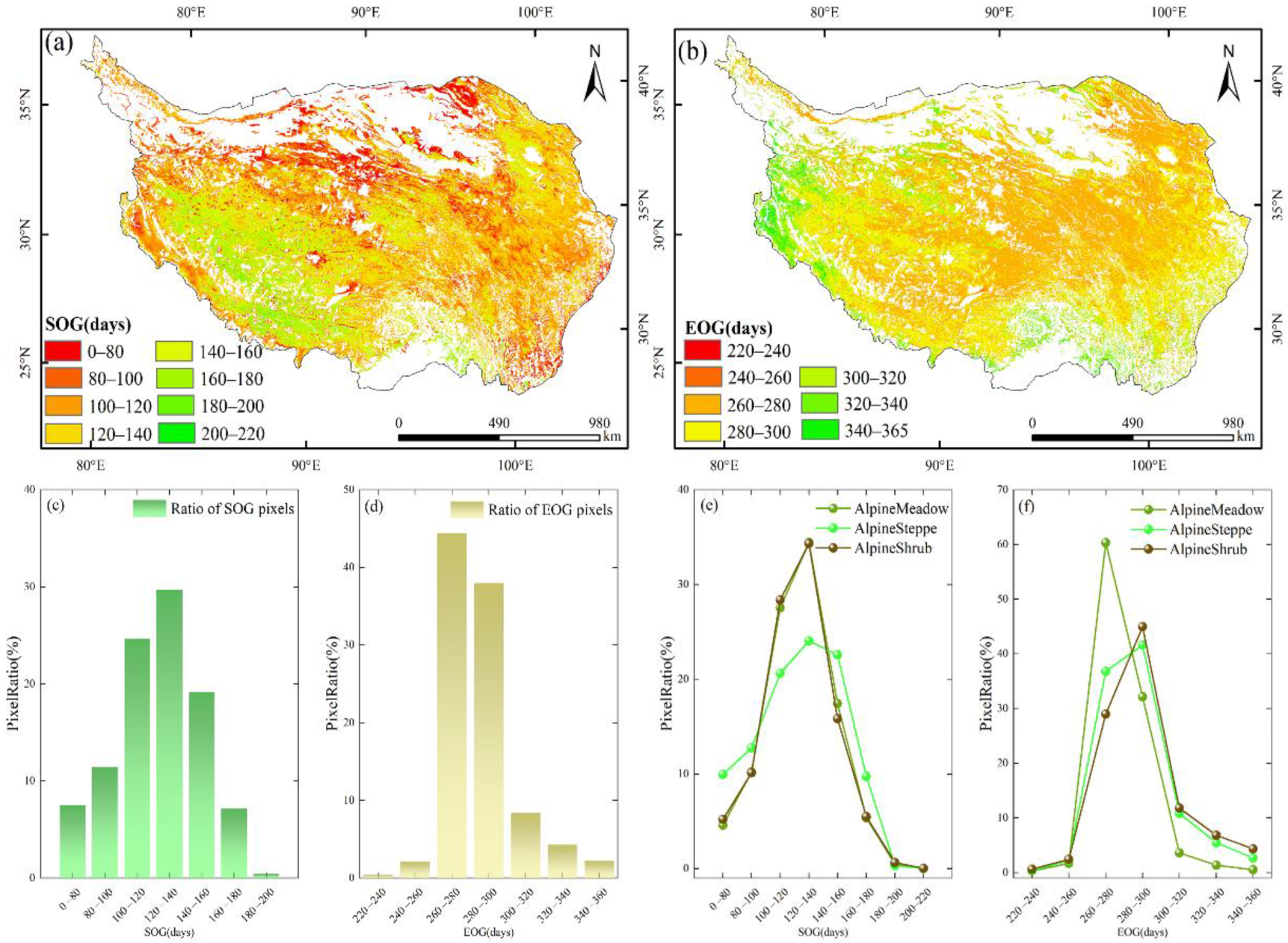
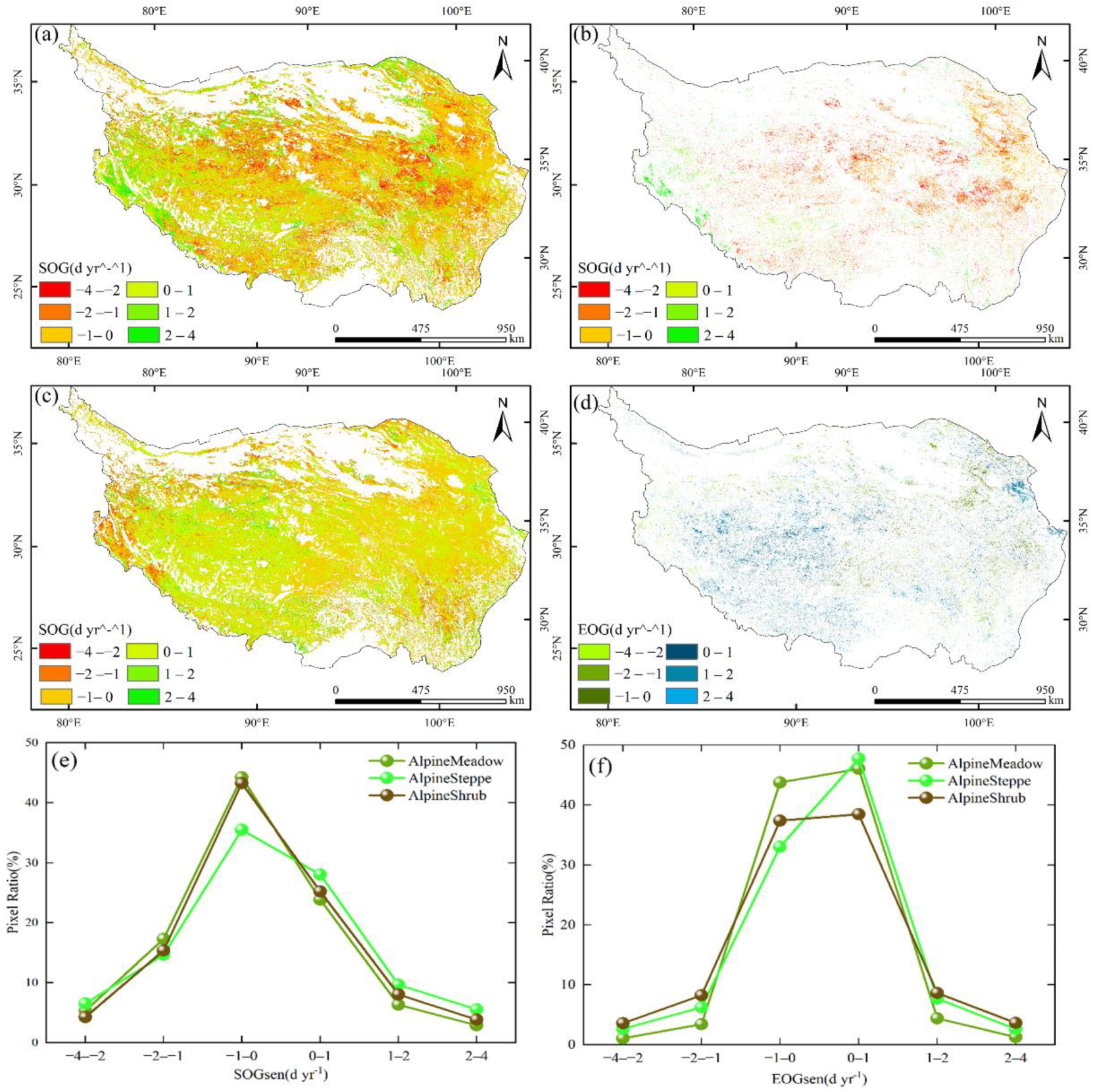


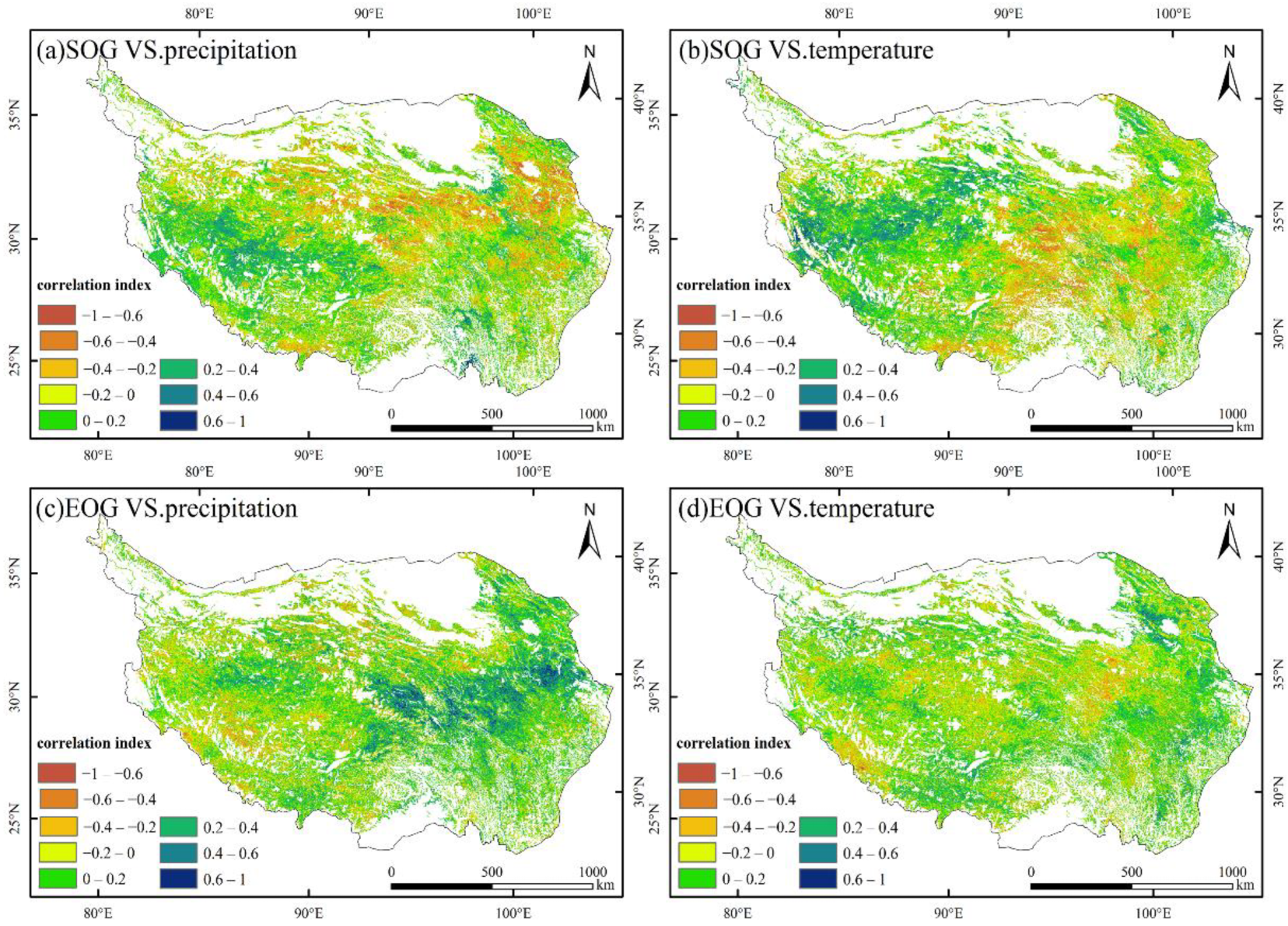
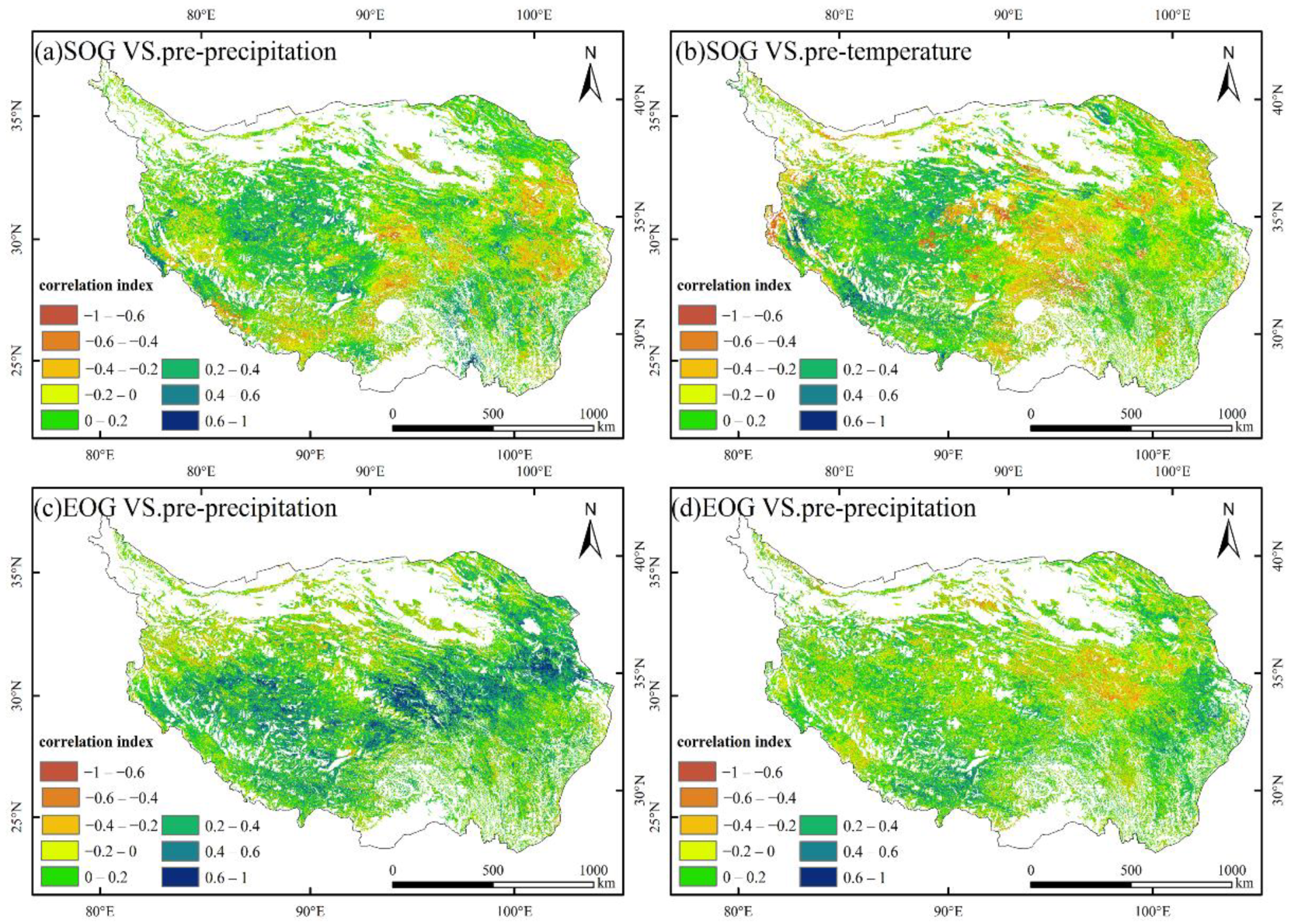
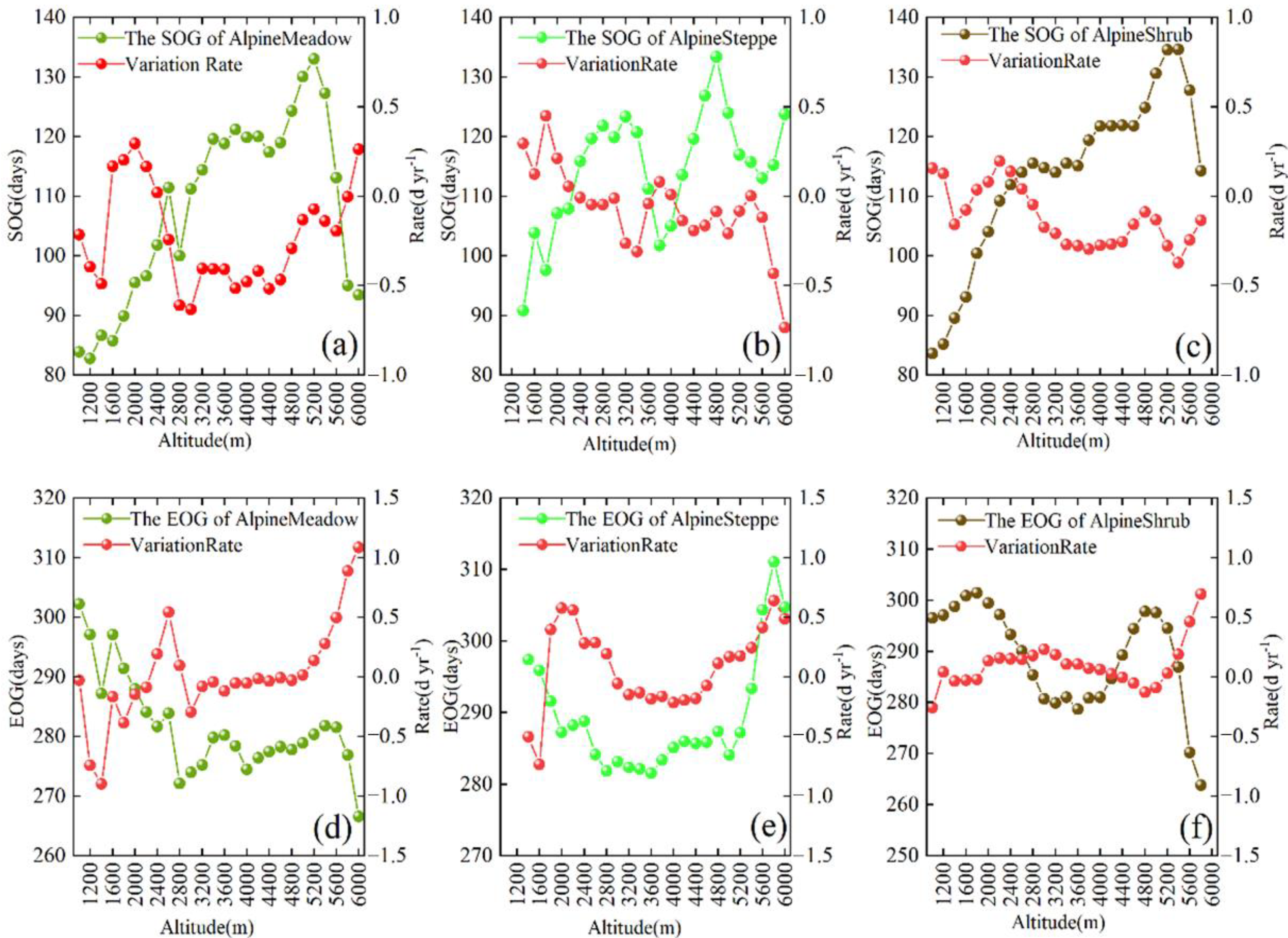
| Vegetation Type | SOG/EOG Change Trend Maximum (d year−1) | SOG/EOG Change Trend Mean (d year−1) | SOG/EOG Change Trend Minimum (d year−1) |
|---|---|---|---|
| Meadow | 1.36/1.44 | −0.40/0.11 | −3.21/−1.52 |
| Steppe | 2.19/1.03 | −0.19/0.10 | −2.83/−1.16 |
| Shrub | 1.77/2.05 | −0.28/0.11 | −2.32/−1.97 |
| Vegetation Type\R(%) | (−1–−0.6) | (−0.6–−0.4) | (−0.4–−0.2) | (−0.2–0) | (0–0.2) | (0.2–0.4) | (0.4–0.6) | (0.6–1) | |
|---|---|---|---|---|---|---|---|---|---|
| Alpine Meadow | R(SOG) | 0.19 | 2.6 | 4.79 | 2.61 | −3.19 | −4.95 | −1.83 | −0.23 |
| R(EOG) | 0.1 | 1.22 | 4.51 | 6.1 | 2.81 | −3.38 | −6.45 | −4.9 | |
| Alpine Steppe | R(SOG) | 0.53 | 4.04 | 7.51 | 4.19 | −5.21 | −8.03 | −2.71 | −0.33 |
| R(EOG) | 0.13 | 1.51 | 6.11 | 9.43 | 2.71 | −8.14 | −8.89 | −2.86 | |
| Alpine Shrub | R(SOG) | −0.01 | 1.25 | 2.68 | 2.92 | −0.3 | −3.9 | −2.34 | −0.3 |
| R(EOG) | 0.03 | 0.54 | 2.18 | 2.41 | 0.47 | −1.29 | −2.87 | −1.47 |
| Vegetation Type\R(%) | (−1–−0.6) | (−0.6–−0.4) | (−0.4–−0.2) | (−0.2–0) | (0–0.2) | (0.2–0.4) | (0.4–0.6) | (0.6–1) | |
|---|---|---|---|---|---|---|---|---|---|
| Alpine Meadow | R(SOG) | −0.16 | 2.91 | 3.77 | 0.19 | −3.60 | −1.61 | −1.16 | −0.35 |
| R(EOG) | −0.08 | −0.22 | 0.96 | 2.72 | 1.29 | −2.04 | −2.26 | −0.38 | |
| Alpine Steppe | R(SOG) | −0.82 | −1.67 | −1.77 | 4.34 | 1.77 | −4.12 | 2.25 | 0.01 |
| R(EOG) | −0.02 | 0.05 | 2.56 | 3.41 | −1.42 | −2.97 | −1.41 | −0.21 | |
| Alpine Shrub | R(SOG) | −0.76 | 0.84 | 4.38 | 1.95 | −4.53 | −1.52 | −0.19 | −0.17 |
| R(EOG) | −0.04 | 0.81 | 3.03 | 1.63 | −2.18 | −2.13 | −0.86 | −0.26 |
| Study Region | Study Time | Fittering | Phenology Identification Method | SOG Mean (Day) | EOG Mean (Day) | Data Resource |
|---|---|---|---|---|---|---|
| QTP | 2001–2018 [33] | S-G filtering | Dynamic Threshold Method | 129 | 266 | MOD13A2 |
| 2001–2015 [10,34] | S-G filtering | 137 | 286 | MOD13A1 | ||
| 1982–2006 [12] | S-G filtering | 135 | 273 | GIMMS NDVI | ||
| 2003–2013 [35] | S-G filtering | 123 | 289 | MOD13Q1 | ||
| 2000–2019 [36] | Hants | 128 | 276 | MOD13Q1 | ||
| 2001–2020 * | S-G filtering | 122 | 282 | MOD13Q1 |
Publisher’s Note: MDPI stays neutral with regard to jurisdictional claims in published maps and institutional affiliations. |
© 2022 by the authors. Licensee MDPI, Basel, Switzerland. This article is an open access article distributed under the terms and conditions of the Creative Commons Attribution (CC BY) license (https://creativecommons.org/licenses/by/4.0/).
Share and Cite
Feng, Z.; Chen, J.; Huang, R.; Yang, Y.; You, H.; Han, X. Spatial and Temporal Variation in Alpine Vegetation Phenology and Its Response to Climatic and Topographic Factors on the Qinghai–Tibet Plateau. Sustainability 2022, 14, 12802. https://doi.org/10.3390/su141912802
Feng Z, Chen J, Huang R, Yang Y, You H, Han X. Spatial and Temporal Variation in Alpine Vegetation Phenology and Its Response to Climatic and Topographic Factors on the Qinghai–Tibet Plateau. Sustainability. 2022; 14(19):12802. https://doi.org/10.3390/su141912802
Chicago/Turabian StyleFeng, Zihao, Jianjun Chen, Renjie Huang, Yanping Yang, Haotian You, and Xiaowen Han. 2022. "Spatial and Temporal Variation in Alpine Vegetation Phenology and Its Response to Climatic and Topographic Factors on the Qinghai–Tibet Plateau" Sustainability 14, no. 19: 12802. https://doi.org/10.3390/su141912802
APA StyleFeng, Z., Chen, J., Huang, R., Yang, Y., You, H., & Han, X. (2022). Spatial and Temporal Variation in Alpine Vegetation Phenology and Its Response to Climatic and Topographic Factors on the Qinghai–Tibet Plateau. Sustainability, 14(19), 12802. https://doi.org/10.3390/su141912802





